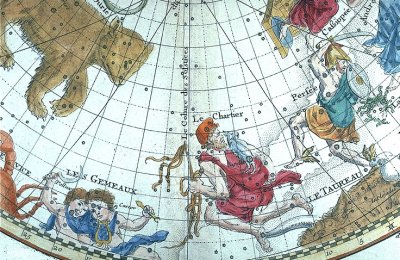
"Why did not somebody teach me the constellations, and make me at home in the starry heavens,
which are always overhead, and which I don't half know to this day?"
~ Thomas Carlyle 1880
The sky is divided into 88 parts called constellations. In a modern sense, the divisions
are large regions on a map similar to countries or states.
They are grouped into 8 distinct subgroups or families, with some overlapping.
These groupings are based on mythological or other associating factors.
You may find it helpful to learn your way across the sky based on these groups.
I. The Ursa Major Family
Ursa Major
Ursa Minor
Draco
Canes Venatici
Boötes
Coma Berenices
Camelopardalis
Lynx
Leo Minor
Corona Borealis
II. The Zodiac
Leo
Virgo
Libra
Scorpius
Sagittarius
Capricornus
Aquarius
Pisces
Aries
Taurus
Gemini
Cancer
III. The Perseus Family
Perseus
Cassiopeia
Cepheus
Andromeda
Pegasus
Cetus
Auriga
Lacerta
Triangulum
IV. The Hercules Family
Hercules
Sagitta
Aquila
Lyra
Cygnus
Vulpecula
Hydra
Sextans
Crater
Corvus
Ophiuchus
Serpens
Scutum
Centaurus
Lupus
Corona Australis
Ara
Triangulum Australe
Crux
V. The Orion Family
Orion
Canis Major
Canis Minor
Monoceros
Lepus
VI. The Heavenly Waters
Delphinus
Equuleus
Eridanus
Pisces Austrinus
Carina
Puppis
Vela
Pyxis
Columba
VII. The Bayer Group (named by Johann Bayer)
Hydrus
Dorado
Volans
Apus
Pavo
Grus
Phoenix
Tucana
Indus
Chamaeleon
Musca
VIII. The Lacaille Family (named by Nicolas Louis de Lacaille)
Norma
Circinus
Telescopium
Microscopium
Fornax
Caelum
Horologium
Octans
Mensa
Reticulum
Pictor
Antlia
The alphabetical listing below is of 51 constellations observable from northern latitudes during the
course of a year.
Andromeda
Aquarius, the water bearer
Aquila, the eagle
Aries, the ram
Auriga the charioteer
Boötes, the bear driver
Camelopardalis, the giraffe
Cancer, the crab
Canes Venatici, hunting dogs
Canis Major, larger dog
Canis Minor, smaller dog
Capricornus, sea goat
Cassiopeia
Cepheus, Cepheus
Cetus, the whale
Coma Berenices, Berenices' hair
Corona Borealis, northern crown
|
Corvus, the crow
Crater, the cup
Cygnus, the swan
Delphinus, the dolphin
Draco, the dragon
Equuleus, the little horse
Eridanus, the river
Gemini, the twins
Hercules
Hydra, the sea serpent
Lacerta, the lizard
Leo, the lion
Leo Minor, the small lion
Libra, the scales
Lynx
Lyra, the lyre
Monoceros, the unicorn
|
Ophiuchus, serpent holder
Orion
Pegasus, the winged horse
Perseus
Pisces, the fishes
Puppis, the ship's stern
Sagitta, the arrow
Sagittarius, the archer
Scorpius, the scorpion
Scutum, the shield
Serpens, the snake
Taurus, the bull
Triangulum, the triangle
Ursa Major, the large bear
Ursa Minor, the small bear
Virgo, the maiden
Vulpecula, the fox
|
|
|
Some of the constellations listed above are near the equator and thus visible from both north and
south latitudes.
The listing below is the 36 constellations observable only from southern latitudes during the course of a year.
Antlia, the air pump
Apus, bird of paradise
Ara, the altar
Caelum, the sculptor's chisel
Carina, the keel
Centaurus, the centaur
Chamaeleon, the chameleon
Circinus, the compasses
Columba, the dove
Corona Austrina, the southern crown
Crux, the cross
Dorado, the swordfish
|
Fornax, the laboratory furnace
Grus, the crane
Horologium, the clock
Hydrus, the water snake
Indus, the american indian
Lupus, the wolf
Mensa, table mountain
Microscopium, the microscope
Musca, the fly
Norma, the carpenter's square
Octans, the octant
Pavo, peacock
|
Phoenix
Pictor, the painter's easle
Piscis Austrinus, the southern fish
Pyxis, the compass box
Reticulum, the net
Sculptor, the sculptor's workshop
Sextans, the sextant
Telescopium, the telescope
Triangulum Australe, the southern triangle
Tucana, the toucan
Vela, the sails
Volans, the flying fish
|
|
|
Abbreviations
|
|